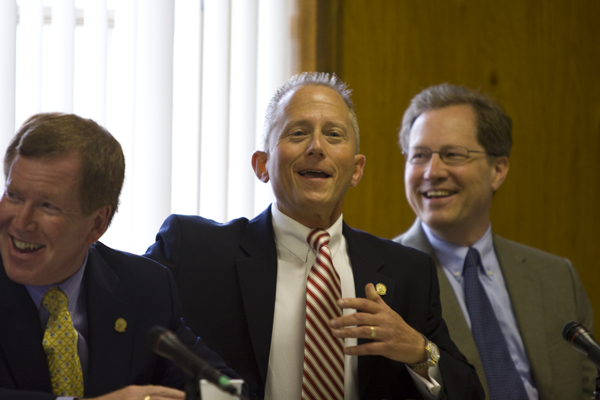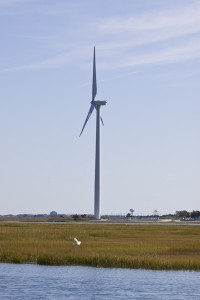
Senator Jeff Van Drew (D-Cape May)

Wind turrbine, Atlantic CIty NJ
Senator Van Drew (D-Cape May) recently introduced legislation S3012 to promote wind power by easing current DEP coastal set back rules:
This bill allows construction of wind dependent energy facilities within 500 feet of the mean high water line of tidal waters pursuant to the “Coastal Area Facility Review Act,â€(CAFRA) provided all other requirements of law, rule or regulation are met. Current DEP regulations permit only water dependent energy facilities to be constructed within 500 feet of the mean high water line. This bill also directs DEP to adopt rules and regulations concerning such permits within 30 days after the date of enactment of the bill into law.
The intent of the Van Drew bill drew praise from Dave Pringle of the NJ Environmental Federation, who took the opportunity to blast DEP CAFRA wind rules:
Dave Pringle, NJ Environmental Federation
David Pringle of the New Jersey Environmental Federation says despite concerns over the impact of windmills on migratory birds, the structures are less invasive than large housing developments, casinos or other structures built on piers. Pringle says current restrictions on clean energy are too stringent.
“They (state government) hold clean renewables like wind energy to a higher standard than the Borgata (casino) or a large housing development,” he said. “That doesn’t pass the straight-face test.” [link to Philadelphia Inquirer article]
But we note that on September 9, 2009, DEP proposed new CAFRA regulations, which would ease current set back rules, among other things:
SUBCHAPTER 7. USE RULES
7:7E-7.4 Energy facility use ruleThe Energy facility use rule contains the standards specific to various energy uses. N.J.A.C. 7:7E-7.4(b) contains standards relevant to siting of any new energy facilities, whereas N.J.A.C. 7:7E-7.4(d) through (s) contain standards specific to a particular type of energy use. The Department proposes to amend the energy facility siting standards at N.J.A.C. 7:7E-7.4(b) to reduce the existing setback for wind and solar energy facilities. The rule currently requires that new energy facilities that are not water dependent be located at least 500 feet inland of the mean high water line of tidal waters. Proposed N.J.A.C. 7:7E-7.4(b)3 would reduce the setback to 50 feet for wind and solar energy facilities, since these facilities would not be anticipated to have the same mass and impact as other energy facilities addressed by this rule. The Department believes that reducing the setback from 500 to 50 feet will facilitate siting of these renewable energy facilities while providing an adequate setback for wildlife use of tidal waters.
The DEP CAFRA rules are virtually identical to the Van Drew bill with respect to easing the current 500 foot set back to promote wind and solar power.
The Van Drew bill drew support of Pringle – the DEP CAFRA rules were denounced by Pringle.
We realize that there may be other provisions of the DEP CAFRA rules that are not addressed by the Van Drew bill. But as a matter of good government, such technical issues should be resolved by DEP in regulations, not micromanaged by legislative amendments.
Regardless, passing the straight face test requires that one read the Van Drew bill and the DEP rules, and understand the issues.
Additionally, Governor Elect Chris Christie’s proposed moratorium on new regulations would block adoption of the proposed DEP CAFRA wind rules.
Yet the Van Drew bill directs DEP to adopt rules within 30 days of passage.
In the unlikely event that the Van Drew bill were to pass quickly, it too would be blocked by the Christie moratorium.
Passing the straight face test requires full disclosure as well.

